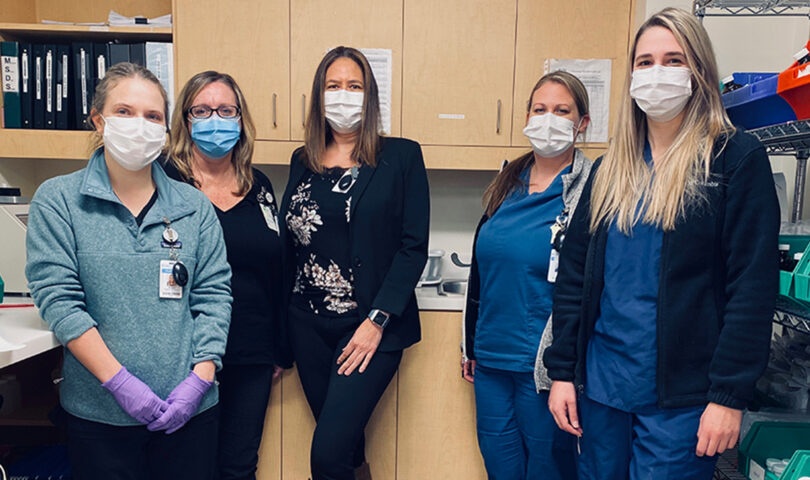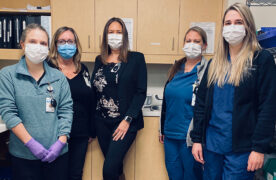Julianne Labelle (centre) is joined by her pharmacy team at the Royal Victoria Regional Health Centre in Barrie.
Pharmacies and pharmacy professionals continue to prepare for full implementation of the NAPRA Model Standards for Pharmacy Compounding of Non-Sterile Preparations by January 1, 2022. Implementing these standards is an important way pharmacy professionals can increase patient safety and protect pharmacy personnel.
Julianne Labelle, registered pharmacist and pharmacy program director at the Royal Victoria Regional Health Centre in Barrie, shared her thoughts with Pharmacy Connection on the impact, challenges and benefits of implementing the standards.
Pharmacy Connection: Describe the impact non-sterile compounding standards has on your practice and safe, quality patient care.
Julianne Labelle: In general, I think the non-sterile compounding standards gave us pause and helped us reflect on which non-sterile preparations we were compounding, and whether we truly had the ability to continue to do so in a safe and effective manner. I think the assessment of preparations and their classification allowed us to have a better understanding of our facilities and what steps needed to be taken in order to continue to compound some of these products.
PC: Describe your approach to completing the first two phases of the standards.
JL: We worked together as a pharmacy leadership team in order to complete the first two phases of the standards. Our first step was to review the standards together, along with any reference/resource materials provided by the College. We felt that before we could even begin to tackle the standards we needed to have a true understanding of what we were trying to achieve. Once we had an understanding of the standards, we set out at completing a gap analysis, reviewing each standard against our current practice, and considering whether that current practice met the standard, or whether we needed to highlight the standard as an area to work on. Following this, we brought in a pharmacy technician who would act as our non-sterile compounding supervisor. The pharmacy technician was instrumental in working with the pharmacy leadership team to work on the first two phases of the standards.
PC: Please share the challenges you experienced in completing Phase 1 and 2 of the standards and how you overcame them.
JL: Our greatest challenge was trying to find the resources to dedicate to this work during a global pandemic. As a pharmacy leadership team, our attention was often elsewhere (back-orders, vaccine clinic). Committing time to this work was difficult. During the pandemic, we also saw an influx of new staff. It was challenging to train new staff to our daily operations, while ensuring they also had the additional training required to meet non-sterile compounding standards. Finally, likely our greatest challenge, and one that we are still working on, is finding an external company to provide expert non-sterile training for our supervisors.
PC: Were there any pharmacy renovations needed as identified by the gap analysis? If so, how are you approaching this ahead of the Phase 3 deadline (ensuring the facility and equipment are in compliance with the standards)?
JL: The pharmacy space/facilities being used for non-sterile compounding meets appropriate requirements for Level A compounding, thus no changes were required. The pharmacy space/facilities in the main department did not meet requirements for Level C compounding. As a result, we moved all Level C compounding, as well as any non-sterile hazardous preparations meeting Level B risk to our sterile hazardous preparation space in the cancer centre. Though the space in the main pharmacy did not meet all requirements for Level B compounding (there is a door in the area leading to a main hospital hallway), we have chosen not to move forward with renovations at this time. The main hospital pharmacy is part of a larger organizational redevelopment plan and is slated to move to new space, which will be compliant with all requirements. We have implemented processes to largely avoid use of the door while we remain in the current space, thereby minimizing opportunity for cross-contamination.
PC: You’ve been willing to share your approach/best practices with other pharmacy professionals – why do you feel this is important?
JL: In general, I think it’s important that the community of pharmacy professionals be willing to share approaches and best practices. In this case, if we can provide information or resources that we have developed, we should not only be proud of our work, but also willing to support our colleagues. We are lucky to have had sufficient resources to dedicate to this work – that may not always be the case with others.
PC: What are some key pieces of advice you’d share with other pharmacy professionals as they work to complete the standards
JL: Take it one standard at a time, and begin with the ones that may have the greatest impact. Get your frontline staff involved, they won’t disappoint. Reach out to others.
PC: Are you willing to provide your contact information so other hospitals can reach out to you for resource sharing opportunities?
JL: Yes, of course. See my contact information below:
Julianne Labelle, BScPharm, MHA, RPh, PMP
Director, Pharmacy Program
Royal Victoria Regional Health Centre
705-728-9090, ext. 43600
labellej@rvh.on.ca
Quick Facts
- The non-sterile compounding standards apply to all pharmacies that perform any type of non-sterile compounding in any quantity, whether once in a while or every day.
- Phase 3—the final implementation phase of the non-sterile compounding standards—is focused on ensuring the facility and equipment required for the preparation of all non-sterile compounds are in compliance with the standards.
- During assessments of pharmacies performing non-sterile compounding, College operations advisors will be looking for completion of Phase 1 and Phase 2 activities as those deadlines have now passed, and can help answer questions about the Phase 3 implementation.













